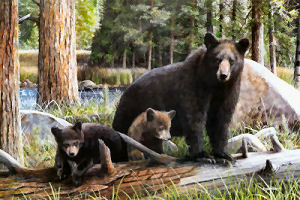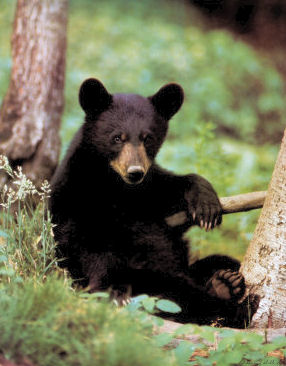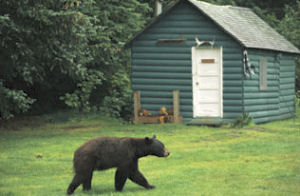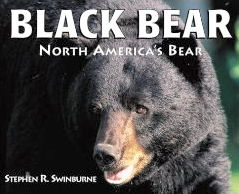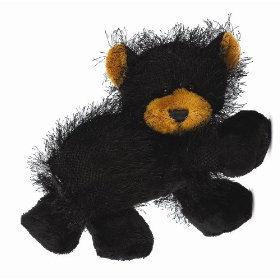Alabama State Mammal
| Black Bear |
Ursus americanus |
Adopted:April 12, 2006 |
Adoption of the Alabama State Mammal
In 2005, a project was conceived by Shirley West, Director of Turtle Point Science Center in Flomatin, Shiren McGlothren, teacher at Escambia County Middle School in Atmore, and her 8th grade science students.
The project to research and promote the black bear as an official representative of Alabama was intended to teach the group of students how bills were prepared, presented, and passed into law.
The students chose the black bear because it is Alabama's largest mammal and is in need of special attention.
According to The Alabama Wildlife Federation (AWF) at the time, the black bear, once abundant throughout Alabama, was most commonly sighted only in Choctaw, Clarke, Mobile, Baldwin and Washington counties in south Alabama. Additionally, a report from the Alabama Department of Conservation indicated that there were no more than 50 bears in southwest Alabama.
On Thursday, January 24, 2005 the Escambia County Middle School students, and their teacher Shiren McGlothren, gathered with a group of supporters at the Turtle Point Environmental Science Center.
Shirley West, Director of Turtle Point, Marisa Lee-Sasser, Communication Director of The Alabama Wildlife Federation, Sonya Wood Mahler of the Alabama Cooperative Extension Service, and Sallye Longshore of the Alabama Board of Education's Environmental Education Division were also in attendance.
State Senator W.H. "Pat" Lindsey and State Representative Frank P. "Skippy" White, representatives of Escambia County, were also present to receive a petition to make the Alabama Black Bear the state's official mammal.
"I will accept this petition and I will present a resolution to our legislature," Lindsey told the students in Turtle Point's education center. 1
The students drafted the original proposal to make the black bear the state's official mammal and several groups across the state, including the Alabama Wildlife Federation, provided support.
"The AWF supported this project 100 percent," said Tim Gothard, the Executive Director of the AWF. "It will provide another useful venue through which we can highlight the Alabama black bear, and hopefully, secure the black bear for future generations." 2
Less than two weeks after the Turtle Point meeting, on February 3, 2005, State Senator Lindsey introduced Senate Bill No. 189. It was read in the Senate and referred to the Senate Committee on Economic Expansion and Trade where it stayed. No further action was taken on this bill. As Janet Little Cooper remarked in The Atmore Advance, "the bill along with the black bear went into hibernation...." 3
Representative Skippy White introduced a similar bill in the State House of Representatives. It was read for the first time in the House on February 8, 2005. House Bill No. 322 met with more success than its Senate counterpart, but by May it was also stuck in committee.
The students did receive something in return for their efforts, however. Senator Lindsey also introduced Senate Joint Resolution No. 9 commending the students at Escambia County Middle School for their "Black Bear Studies." It was approved by both houses of the Alabama Legislature.
COMMENDING THE EIGHTH GRADE SCIENCE CLASS OF ESCAMBIA COUNTY FOR BLACK BEAR STUDIES.
WHEREAS, the members of the eighth grade Science Class of Escambia County Middle School and their teachers recently concluded extensive studies on the Black Bear, which is native to Southwest Alabama, where its population is estimated to be from 50 to several hundred; and
WHEREAS, these students are to be commended for undertaking this project and leading efforts to gain official recognition of the remarkable Black Bear, which represents the awesome beauty and power of nature and the importance of preserving wilderness in these modern times; and
WHEREAS, the class discovered that the Black Bear is the smallest in North America, having thick black fur, weighing about 300 pounds, and reaching four to six feet in length; these gentle animals eat very little meat, preferring nuts, berries, grasses, roots, and honey, and they pose little threat to humans unless provoked or threatened; and
WHEREAS, the Science Class members were so thoroughly impressed by the native Alabama Black Bear that they recommended that it be officially recognized by the state; now therefore,
BE IT RESOLVED BY THE LEGISLATURE OF ALABAMA, BOTH HOUSES THEREOF CONCURRING, That by copy of this resolution, we hereby commend the eighth grade Science students and teachers at Escambia County Middle School for their dedicated efforts and accomplishments in conducting their study of, and advocating the official recognition of, the Alabama Black Bear.
The 2005 Alabama Legislature adjourned and the Escambia County Middle School 8th graders went on to summer vacation and then into 9th Grade.
When the Alabama Legislature convened in January, 2006, Senator Lindsey was back with another bill, Senate Bill No. 76, to promote the black bear as Alabama's official state mammal.
This year, things were different and, on January 19, the Senate voted unanimously (25-0) in approval of the legislation.
By March 9, 2006, the House had passed the legislation (87-1) and forwarded the enrolled bill to the Governor, requesting his signature.
On April 12, 2006, Governor Bob Riley, joined by students from Escambia County schools, signed Senate Bill No. 76, making the black bear Alabama's official state mammal.
By March 9, 2006, the House had passed the legislation (87-1) and forwarded the enrolled bill to the Governor, requesting his signature.
On April 12, 2006, Governor Bob Riley, joined by students from Escambia County schools, signed Senate Bill No. 76, making the black bear Alabama's official state mammal.
For the Escambia County students, their teacher Shiren McGlothren, and the Director at Turtle Point Science Center, Shirley West, it was the end of a long and productive class project. 3
"The students learned so much," said Shirley West, Director of Turtle Point Science Center. "It was a wonderful hands-on experience for them. They were able to start from the beginning and have a positive outcome. "Being able to make a difference meant so much to these kids and I believe they will carry this rewarding experience with them for a long time." 3
Alabama Law
The following information was excerpted from the The Code of Alabama 1975, Title 1, Chapter 2.
TITLE 1.
Chapter 2 STATE SYMBOLS AND HONORS.
Section 1-2-36 State mammal.
Section 1-2-36
State mammal.
The Black Bear, subfamily ursinae, Ursus americanus Pollas, 1780, is hereby designated as the official state mammal of Alabama.
(Act 2006-245, §1.)
Source: Alabama State Legislature, The Code of Alabama 1975, , September 30, 2008.
Source: Alabama State Legislature (http://www.legislature.state.al.us/), September 30, 2008.
Source: 1 The Atmore Advance, Students enter political arena by Jim Cottrell. January 24, 2005.
Source: 2 The Alabama Wildlife Federation, Thanks to Escambia County students, Alabama has an official state mammal. March 23, 2006.
Source: 3 The Atmore Advance,ECMS petition finally becomes law by Janet Little Cooper. May 15, 2006.
Additional Information
State mammal of Alabama: Black Bear:
Official Symbols and Emblems of Alabama from the Alabama Department of Hisotry & Archives.
Ursus americanus: American black bear:
University of Michigan Museum of Zoology: Animal Diversity Web.
Alabama Black Bear Alliance:
Alabama Black Bear Alliance is a coalition of diverse interests with the goal of working cooperatively and voluntarily for the conservation of the black bear in Alabama through research, education, and habitat management. Sponsored by the Alabama Wildlife Federation.
The Alabama Wildlife Federation:
Web site of the Alabama Wildlife Federations: Working for wildlife since 1935.
North American Bear Center:
North American Bear Center intends to advance the long-term survival of bears worldwide by replacing misconceptions with scientific facts about bears, their role in ecosystems, and their relations with humans. .
Official state mammals:
Complete list of official state mammals from NETSTATE.COM.
Black Bear: North America's Bear,
by Stephen R. Swinburne, Reading level: Ages 9-12, 32 pages, Boyds Mills Press; 1 edition (August 2003) Stunning, full-color photos and a lively text make for an intriguing introduction to these fascinating animals. Swinburne traveled to several locales to observe biologists at work, including a licensed wildlife rehabilitator in New Hampshire who has mentored orphaned cubs for 10 years.
Living With Bears: A Practical Guide to Bear Country,
by Linda Masterson, 256 pages, PixyJack Press (April 1, 2006) Linda Masterson dispels myths, replaces fear with respect, and lays the foundation for improving human-black bear relations with an inside look at the fascinating world of these highly intelligent, adaptable and resourceful animals found in 41 U.S. states and every province in Canada.
Black Bears: A Natural History,
by Dave Taylor, 256 pages, Fitzhenry and Whiteside; 1 edition (July 28, 2006) If you have an interest in bears then Dave Taylor's sixteen years of research and photographs will keep your interest for hours with his new book.
Webkinz® Black Bear,
The virtual version of the plush animal comes alive online in Webkinz World when activated with the special code that comes with every plush animal.
Lodge Black Bear Kitchen Paper Towel Holder,
Bear Paper Towel Holder. Papa bear's cubs are mischievous, yet useful on this playful towel holder. Keep paper towels handy throughout your cabin or lodge-style woodland retreat. Wooden dowel has a resin base and finial.
Black Bear Night-light,
Night-light features a mother bear with cub. Great for home or at the lake house or cabin.
Sidney Bear - Black, by GUND,
Black plush bear with goofy grin.
|

